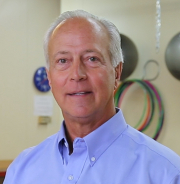As the concept of clinical exercise is being exposed to greater populations, many athletes are asking "what is the difference between a clinical exercise protocol and the regular exercise regime that I am doing?" Most athletes and active people are aware of how advantageous an exercise regime is in their respective sport. If they train their bodies for the sport they are playing they know they will perform better. If they secure the expertise of a trainer they will further their ability to perform successfully in their sport. In fact, their ability to improve performance has been directly related to the knowledge of their trainer. The better educated the trainer and the more they understand the demands of your sport, the better you will do in your sport.
In professional sports the athlete and the sports medicine specialist are constantly searching for ways to improve performance. Over the past 20 years working on the PGA Tour sports medicine staff, it has been great to see the growth of exercise usage to improve performance. Gary Player was way ahead of his time when he incorporated exercise into his daily regime for personal health benefits as well as improving his golf skills. The concept hit home when Tiger Woods came on the scene in 1997 looking like an NFL defensive back, but able to hit a ball 300+ yards and chip and putt with a phenomenal touch. I also began my work with the PGA Tour golfers in 1997 and have happily witnessed a tremendous growth in the number of golfers utilizing trainers to improve their abilities.
It is now 2017 and over the past few years sports medicine specialists have gotten more involved with enhancing performance. In the past the athlete would find out who was the best at training them for their sport and put them to work. Sometimes though, even the best athletes would hit ceilings on their capabilities and their response to training would "peak out". Progressions and training objectives frequently would become compromised and taper off. This is when sports medicine specialists began to look into possible reasons for the unexplained limitations.
Trainers were doing phenomenal work with athletes regarding flexibility and strength. As sports medicine specialists we began to look at what possible body functions may be limiting their progress. Through clinical evaluations we found that many golfers did not have adequate mobility and/or stability in various joints, connective tissues, and muscles in their bodies to progress beyond a certain level of training. This effected their movement patterns which would limit their ability to perform exercises properly. Exercises were beneficial to them, but the result could be improved if these deficits were detected and corrected or improved upon. In some cases, certain exercises inhibited the benefit of other exercises because they were being performed in regions that were dysfunctional from a mobility and/or stability perspective. The result was being in a situation where some exercises were promoting dysfunction.
Therefore it is critical to do a Clinical Golf (Sport) Performance Evaluation to detect changes in mobility and stability that would limit the body's capabilities to perform with their trainers, PGA instructors, and on the golf course. If there are positive findings on the evaluation, clinical golf exercises are given to address the deficits in mobility or stability so as to enhance the capability of the golfer to meet their objectives with their trainer. Additionally, if there is a history of injury, the sports medicine clinician is able to assess if that is creating any problems or challenging other areas of the body. If treatment is necessary to restore mobility or enhance muscular activation, the clinician is trained and prepared to to address such issues.
The objective of the clinical golf performance evaluation and exercise protocol is to enhance the physical capability of the golfer. The golfer benefits by having input that provides an exercise regime that is specific to their needs. The trainer benefits by having mobility and stability issues cleared and getting a golfer that is capable of performing their training demands. The PGA instructor benefits by being better able to implement their technical expertise since the golfer is now capable of executing their recommendations.
A template of potential body structures that can inhibit performance results from such a detailed evaluation. The clinical performance evaluation additionally provides a means of monitoring body function as it is subjected to the ongoing repetitive challenges of golf. Periodically the body can be checked and treatment or exercises refined to address potential injury sites or biomechanical dysfunction that may be developing. All together - the PGA instructor, trainer, and sports medicine clinician provide a solid support team for improving golf performance.

